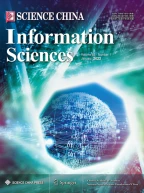Abstract
In this paper, we propose a low-complexity frequency slicing deep neural network (FSDNN) for wide-band signal post-equalization in a 1.2 m underwater visible light communication system. FSDNN and deep neural network (DNN) outperform the least mean square equalizer. Then, by splitting the received signal into two parallel signals using a digital low-pass filter and a high-pass filter, we demonstrate that the FSDNN significantly reduces the complexity of the traditional DNN post-equalizer. Moreover, the complexity of the FSDNN decreases considerably to 11.15% compared with the conventional DNN for a 2.7 Gbit/s wide-band transmitted signal with a similar bit error ratio performance.
Similar content being viewed by others
Explore related subjects
Discover the latest articles, news and stories from top researchers in related subjects.References
Zeng Z Q, Fu S, Zhang H H, et al. A survey of underwater optical wireless communications. IEEE Commun Surv Tut, 2017, 19: 204–238
Chi N, Haas H, Kavehrad M, et al. Visible light communications: demand factors, benefits and opportunities. IEEE Wirel Commun, 2015, 22: 5–7
Zhou Y J, Zhu X, Hu F C, et al. Common-anode LED on a Si substrate for beyond 15 Gbit/s underwater visible light communication. Photon Res, 2019, 7: 1019–1029
Zhao Y H, Zou P, Yu W X, et al. Two tributaries heterogeneous neural network based channel emulator for underwater visible light communication systems. Opt Exp, 2019, 27: 22532–22541
Chi N, Hu F C. Nonlinear adaptive filters for high-speed LED based underwater visible light communication. Chin Opt Lett, 2019, 17: 100011
Chi N, Zhao Y, Shi M, et al. Gaussian kernel-aided deep neural network equalizer utilized in underwater PAM8 visible light communication system. Opt Exp, 2018, 26: 26700–26712
Wu F M, Lin C T, Wei C C, et al. Performance comparison of OFDM signal and CAP signal over high capacity RGB-LED-based WDM visible light communication. IEEE Photon J, 2013, 5: 7901507–7901507
Ziemer R E, Tranter W H. Principles of Communications. Hoboken: John Wiley Sons, 2014
Zibar D, Piels M, Jones R, et al. Machine learning techniques in optical communication. J Lightw Technol, 2016, 34: 1442–1452
Khan F N, Lu C, Lau A P T. Machine learning methods for optical communication systems. In: Proceedings of Signal Processing in Photonic Communications, 2017. 3
Li G, Hu F, Zhao Y, et al. Enhanced performance of a phosphorescent white LED CAP 64QAM VLC system utilizing deep neural network (DNN) post equalization. In: Proceedings of IEEE/CIC International Conference on Communications in China (ICCC), Changchun, 2019. 173–176
Osahon I N, Rajbhandari S, Popoola W O. Performance comparison of equalization techniques for SI-POF multi- Gigabit communication with PAM-M and device non-linearities. J Lightw Technol, 2018, 36: 2301–2308
Kaushal H, Kaddoum G. Underwater optical wireless communication. IEEE Access, 2016, 4: 1518–1547
Ali M A A, Mohammed M A. Effect of atmospheric attenuation on laser communications for visible and infrared wavelengths. Al-Nahrain J Sci, 2013, 16: 133–140
Johnson L, Green R, Leeson M. A survey of channel models for underwater optical wireless communication. In: Proceedings of 2013 2nd International Workshop on Optical Wireless Communications (IWOW), 2013. 1–5
Cossu G. Recent achievements on underwater optical wireless communication. Chin Opt Lett, 2019, 17: 100009
Huang X X, Wang Z X, Shi J Y, et al. 1.6 Gbit/s phosphorescent white LED based VLC transmission using a cascaded pre-equalization circuit and a differential outputs PIN receiver. Opt Express, 2015, 23: 22034–22042
Kim J, Konstantinou K. Digital predistortion of wideband signals based on power amplifier model with memory. Electron Lett, 2001, 37: 1417–1418
Ju C, Liu N, Chen X, et al. SSBI mitigation in A-RF-tone-based VSSB-OFDM system with a frequency-domain volterra series equalizer. J Lightw Technol, 2015, 33: 4997–5006
Zhang J W, Yu J J, Li F, et al. 11×5×9.3 Gb/s WDM-CAP-PON based on optical single-side band multi-level multi-band carrier-less amplitude and phase modulation with direct detection. Opt Exp, 2013, 21: 18842–18848
Burse K, Yadav R N, Shrivastava S C. Channel equalization using neural networks: a review. IEEE Trans Syst Man Cybern C, 2010, 40: 352–357
Zhou Y, Zhang J, Wang C, et al. A novel memoryless power series based adaptive nonlinear pre-distortion scheme in high speed visible light communication. In: Proceedings of Optical Fiber Communication Conference and Exhibition (OFC), 2017
Haykin S O. Neural Networks and Learning Machines. Upper Saddle River: Pearson, 2009. 3
Acknowledgements
This work was partially supported by National Key Research and Development Program of China (Grant No. 2017YFB0403603) and Natural National Science Foundation of China (Grant No. 61925104).
Author information
Authors and Affiliations
Corresponding author
Rights and permissions
About this article
Cite this article
Chi, N., Hu, F., Li, G. et al. AI based on frequency slicing deep neural network for underwater visible light communication. Sci. China Inf. Sci. 63, 160303 (2020). https://doi.org/10.1007/s11432-020-2851-0
Received:
Accepted:
Published:
DOI: https://doi.org/10.1007/s11432-020-2851-0
